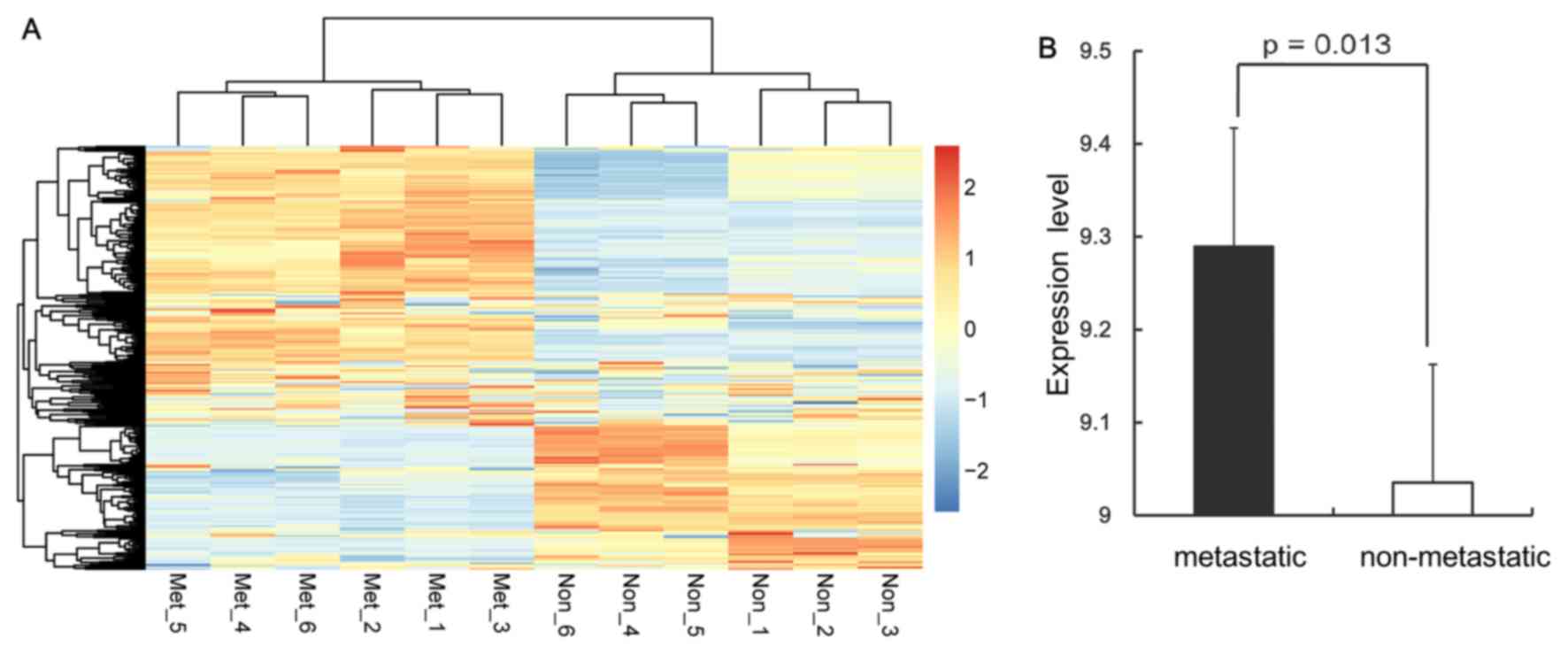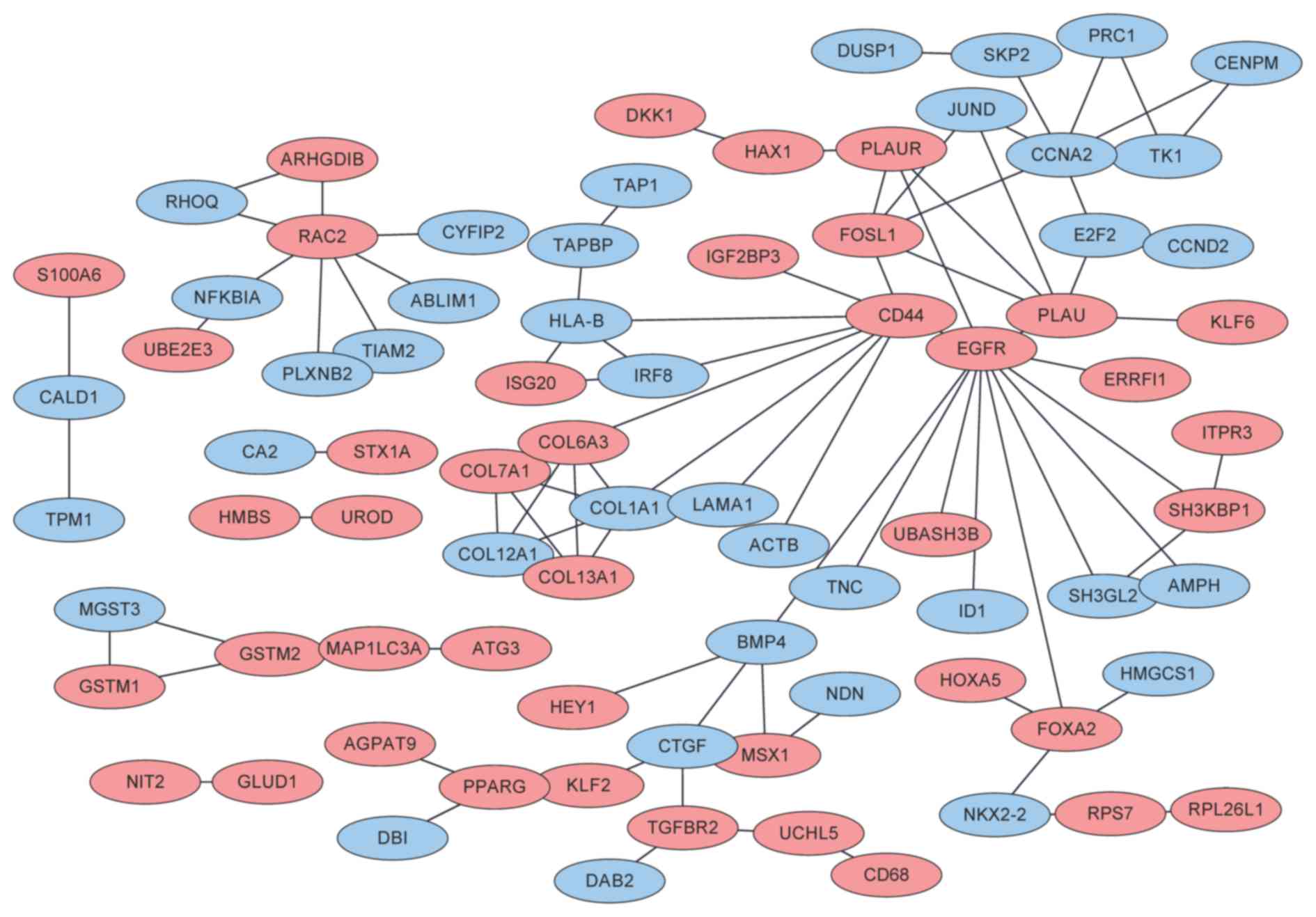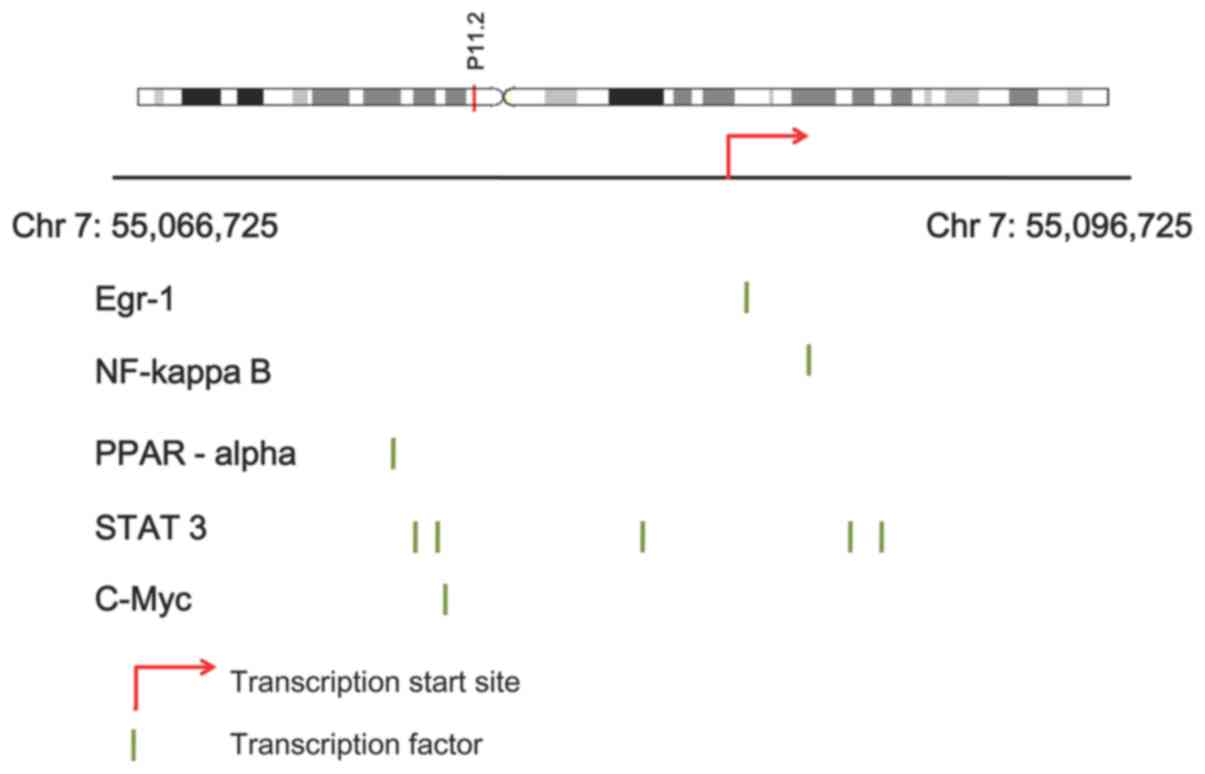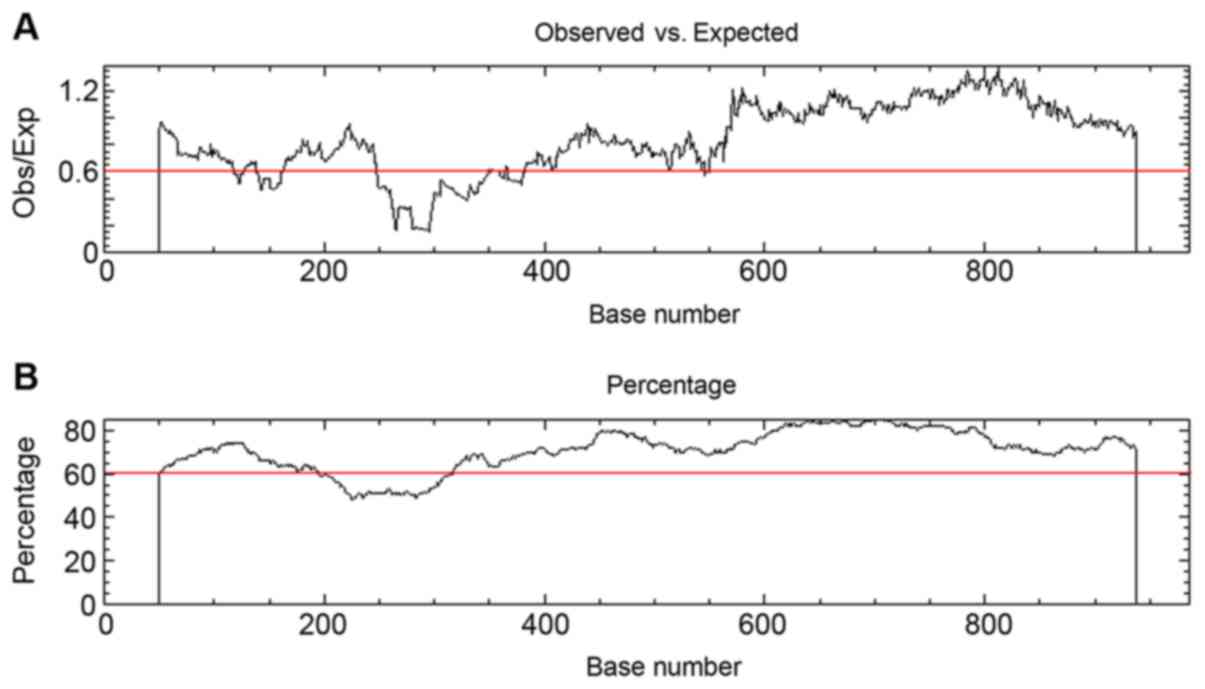|
1
|
Luetke A, Meyers PA, Lewis I and Juergens
H: Osteosarcoma treatment - where do we stand? A state of the art
review. Cancer Treat Rev. 40:523–532. 2014. View Article : Google Scholar : PubMed/NCBI
|
|
2
|
Moore DD and Luu HH: Osteosarcoma. Cancer
Treat Res. 162:65–92. 2014. View Article : Google Scholar : PubMed/NCBI
|
|
3
|
Ottaviani G, Jaffe N, Eftekhari F, Raymond
AK and Yasko AW: Pediatric and Adolescent Osteosarcoma. Springer;
Berlin: 2011
|
|
4
|
Ottaviani G and Jaffe N: The epidemiology
of osteosarcoma. Cancer Treat Res. 152:3–13. 2009. View Article : Google Scholar : PubMed/NCBI
|
|
5
|
Zhao S, Kurenbekova L, Gao Y, Roos A,
Creighton CJ, Rao P, Hicks J, Man TK, Lau C, Brown AM, et al: NKD2,
a negative regulator of Wnt signaling, suppresses tumor growth and
metastasis in osteosarcoma. Oncogene. 34:5069–5079. 2015.
View Article : Google Scholar : PubMed/NCBI
|
|
6
|
Fujiwara T, Takahashi RU, Kosaka N, Nezu
Y, Kawai A, Ozaki T and Ochiya T: RPN2 gene confers osteosarcoma
cell malignant phenotypes and determines clinical prognosis. Mol
Ther Nucleic Acids. 3:e1892013. View Article : Google Scholar
|
|
7
|
Wang L, Zhang Q, Chen W, Shan B, Ding Y,
Zhang G, Cao N, Liu L and Zhang Y: B7-H3 is overexpressed in
patients suffering osteosarcoma and associated with tumor
aggressiveness and metastasis. PLoS One. 8:e706892013. View Article : Google Scholar : PubMed/NCBI
|
|
8
|
Yang H, Zhang Y, Zhou Z, Jiang X and Shen
A: Transcription factor Snai1-1 induces osteosarcoma invasion and
metastasis by inhibiting E-cadherin expression. Oncol Lett.
8:193–197. 2014. View Article : Google Scholar : PubMed/NCBI
|
|
9
|
Yang G, Yuan J and Li K: EMT transcription
factors: Implication in osteosarcoma. Med Oncol. 30:6972013.
View Article : Google Scholar : PubMed/NCBI
|
|
10
|
Al-Romaih K, Sadikovic B, Yoshimoto M,
Wang Y, Zielenska M and Squire JA: Decitabine-induced demethylation
of 5′ CpG island in GADD45A leads to apoptosis in osteosarcoma
cells 1. Neoplasia. 10:471–480. 2008. View Article : Google Scholar : PubMed/NCBI
|
|
11
|
Endo-Munoz L, Cai N, Cumming A, Macklin R,
Merida de Long L, Topkas E, Mukhopadhyay P, Hill M and Saunders NA:
Progression of osteosarcoma from a non-Metastatic to a metastatic
phenotype is causally associated with activation of an autocrine
and paracrine uPA axis. PLoS One. 10:e01335922015. View Article : Google Scholar : PubMed/NCBI
|
|
12
|
Barrett T, Wilhite SE, Ledoux P,
Evangelista C, Kim IF, Tomashevsky M, Marshall KA, Phillippy KH,
Sherman PM, Holko M, et al: NCBI GEO: Archive for functional
genomics data sets-update. Nucleic Acids Res. 41(Database issue):
D991–D995. 2013.PubMed/NCBI
|
|
13
|
Ritchie ME, Phipson B, Wu D, Hu Y, Law CW,
Shi W and Smyth GK: Limma powers differential expression analyses
for RNA-sequencing and microarray studies. Nucleic acids Res.
43:e472015. View Article : Google Scholar : PubMed/NCBI
|
|
14
|
Haynes W: Benjamini-Hochberg
methodEncyclopedia of Systems Biology. Springer; New York, NY: pp.
782013, View Article : Google Scholar
|
|
15
|
Jarabo A, Buisan R and Gutierrez D:
Bidirectional clustering for scalable VPL-based global
illumination. Spanish Computer Graphics Conference. Moreno JL and
Sber M: Eurographics Association; pp. 1–9. 2015; http://dx.doi.org/10.2312/ceig.20151196
|
|
16
|
Draisma J, Horobeţ E, Ottaviani G,
Sturmfels B and Thomas RR: The Euclidean distance degree of an
algebraic varietyFoundations of Computational Mathematics. 16.
Springer-Verlag; New York, NY: pp. 99–149, 1-51. 2016, View Article : Google Scholar
|
|
17
|
Kolde R: Pheatmap: Pretty Heatmaps.
2015.https://cran.r-project.org/web/packages/pheatmap/index.htmlJuly
2–2015
|
|
18
|
De Winter JCF: Using the Student's
‘t’-test with extremely small sample sizes. Pract Assess Res Eval.
18:122013.
|
|
19
|
Szklarczyk D, Franceschini A, Kuhn M,
Simonovic M, Roth A, Minguez P, Doerks T, Stark M, Muller J, Bork
P, et al: The STRING database in 2011: Functional interaction
networks of proteins, globally integrated and scored. Nucleic Acids
Res. 39(Database issue): D561–D568. 2011. View Article : Google Scholar : PubMed/NCBI
|
|
20
|
Shi Z, Rui W, Feng Y and Guo J:
Bioinformatics Study on Relationship of Hyperlipidemia and
Phospholipids based on Cytoscape Software. Atlantis Press; pp.
357–360. 2014
|
|
21
|
Gene Ontology Consortium, . Gene Ontology
Consortium: Going forward. Nucleic Acids Res. 43(Database Issue):
D1049–D1056. 2015.PubMed/NCBI
|
|
22
|
Kotera M, Moriya Y, Tokimatsu T, Kanehisa
M and Goto S: KEGG and GenomeNet, new developments, metagenomic
analysisEncyclopedia of Metagenomics. Nelson K: Springer; New York,
NY: pp. 329–339. 2015
|
|
23
|
Jiao X, Sherman BT, Huang da W, Stephens
R, Baseler MW, Lane HC and Lempicki RA: DAVID-WS: A stateful web
service to facilitate gene/protein list analysis. Bioinformatics.
28:1805–1806. 2012. View Article : Google Scholar : PubMed/NCBI
|
|
24
|
Xie C, Mao X, Huang J, Ding Y, Wu J, Dong
S, Kong L, Gao G, Li CY and Wei L: KOBAS 2.0: A web server for
annotation and identification of enriched pathways and diseases.
Nucleic Acids Res. 39:W316–W322. 2011. View Article : Google Scholar : PubMed/NCBI
|
|
25
|
Matys V, Kel-Margoulis OV, Fricke E,
Liebich I, Land S, Barre-Dirrie A, Reuter I, Chekmenev D, Krull M,
Hornischer K, et al: TRANSFAC and its module TRANSCompel:
Transcriptional gene regulation in eukaryotes. Nucleic Acids Res.
34(Database issue): D108–D110. 2006. View Article : Google Scholar : PubMed/NCBI
|
|
26
|
Blackledge NP, Thomson JP and Skene PJ:
CpG island chromatin is shaped by recruitment of ZF-CxxC proteins.
Cold Spring Har Perspect Biol. 5:a0186482013. View Article : Google Scholar
|
|
27
|
Sproul D, Kitchen RR, Nestor CE, Dixon JM,
Sims AH, Harrison DJ, Ramsahoye BH and Meehan RR: Tissue of origin
determines cancer-associated CpG island promoter hypermethylation
patterns. Genome Biol. 13:R842012. View Article : Google Scholar : PubMed/NCBI
|
|
28
|
Parker A, Proctor G and Spudich G: Ensembl
2012. Advances in Immunology. 2011.
|
|
29
|
Takai D and Jones PA: The CpG island
searcher: A new WWW resource. In Silico Biol. 3:235–340.
2003.PubMed/NCBI
|
|
30
|
Freeman SS, Allen SW, Ganti R, Wu J, Ma J,
Su X, Neale G, Dome JS, Daw NC and Khoury JD: Copy number gains in
EGFR and copy number losses in PTEN are common events in
osteosarcoma tumors. Cancer. 113:1453–1461. 2008. View Article : Google Scholar : PubMed/NCBI
|
|
31
|
Wang Q, Cai J, Wang J, Xiong C and Zhao J:
miR-143 inhibits EGFR-signaling-dependent osteosarcoma invasion.
Tumour Biol. 35:12743–12748. 2014. View Article : Google Scholar : PubMed/NCBI
|
|
32
|
Hughes DP, Thomas DG, Giordano TJ, Baker
LH and McDonagh KT: Cell surface expression of epidermal growth
factor receptor and Her-2 with nuclear expression of Her-4 in
primary osteosarcoma. Cancer Res. 64:2047–2053. 2004. View Article : Google Scholar : PubMed/NCBI
|
|
33
|
Do SI, Jung WW, Kim HS and Park YK: The
expression of epidermal growth factor receptor and its downstream
signaling molecules in osteosarcoma. Int J Oncol. 34:797–803.
2009.PubMed/NCBI
|
|
34
|
Yu DH, Ware C, Waterland RA, Zhang J, Chen
MH, Gadkari M, Kunde-Ramamoorthy G, Nosavanh LM and Shen L:
Developmentally programmed 3′ CpG island methylation confers
tissue- and cell-type-specific transcriptional activation. Mol Cell
Biol. 33:1845–1858. 2013. View Article : Google Scholar : PubMed/NCBI
|
|
35
|
Mcmahon AP, Champion JE, McMahon JA and
Sukhatme VP: Developmental expression of the putative transcription
factor Egr-1 suggests that Egr-1 and c-fos are coregulated in some
tissues. Development. 108:281–287. 1990.PubMed/NCBI
|
|
36
|
Windischhofer W, Huber E, Rossmann C,
Semlitsch M, Kitz K, Rauh A, Devaney T, Leis HJ and Malle E:
LPA-induced suppression of periostin in human osteosarcoma cells is
mediated by the LPA(1)/Egr-1 axis. Biochimie. 94:1997–2005. 2012.
View Article : Google Scholar : PubMed/NCBI
|
|
37
|
Zhao Z, Wu MS, Zou C, Tang Q, Lu J, Liu D,
Wu Y, Yin J, Xie X, Shen J, et al: Downregulation of MCT1 inhibits
tumor growth, metastasis and enhances chemotherapeutic efficacy in
osteosarcoma through regulation of the NF-κB pathway. Cancer Lett.
342:150–158. 2013. View Article : Google Scholar : PubMed/NCBI
|
|
38
|
Wagner ER, He BC, Chen L, Zuo GW, Zhang W,
Shi Q, Luo Q, Luo X, Liu B, Luo J, et al: Therapeutic Implications
of PPARgamma in Human Osteosarcoma. PPAR Res. 2010:9564272010.
View Article : Google Scholar : PubMed/NCBI
|
|
39
|
Lai R, Navid F, Rodriguez-Galindo C, Liu
T, Fuller CE, Ganti R, Dien J, Dalton J, Billups C and Khoury JD:
STAT3 is activated in a subset of the Ewing sarcoma family of
tumours. J Pathol. 208:624–632. 2006. View Article : Google Scholar : PubMed/NCBI
|
|
40
|
Chen CL, Loy A, Ling C, Chan C, Hsieh FC,
Cheng G, Wu B, Qualman SJ, Kunisada K, Keiko YT and Lin J: Signal
transducer and activator of transcription 3 is involved in cell
growth and survival of human rhabdomyosarcoma and osteosarcoma
cells. BMC Cancer. 7:1112007. View Article : Google Scholar : PubMed/NCBI
|
|
41
|
Ryu K, Susa M, Choy E, Yang C, Hornicek
FJ, Mankin HJ and Duan Z: Oleanane triterpenoid CDDO-Me induces
apoptosis in multidrug resistant osteosarcoma cells through
inhibition of Stat3 pathway. BMC Cancer. 10:1872010. View Article : Google Scholar : PubMed/NCBI
|
|
42
|
Scionti I, Michelacci F, Pasello M,
Hattinger CM, Alberghini M, Manara MC, Bacci G, Ferrari S,
Scotlandi K, Picci P and Serra M: Clinical impact of the
methotrexate resistance-associated genes C-MYC and dihydrofolate
reductase (DHFR) in high-grade osteosarcoma. Ann Oncol.
19:1500–1508. 2008. View Article : Google Scholar : PubMed/NCBI
|
|
43
|
Wu X, Cai ZD, Lou LM and Zhu YB:
Expressions of p53, c-MYC, BCL-2 and apoptotic index in human
osteosarcoma and their correlations with prognosis of patients.
Cancer Epidemiol. 36:212–216. 2012. View Article : Google Scholar : PubMed/NCBI
|














